Antique Victorian Gold Diamond Military Star Order St. Patrick Garter Medal Pin
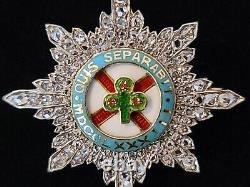
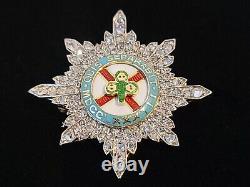
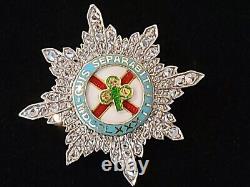
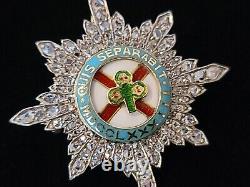
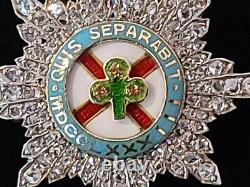
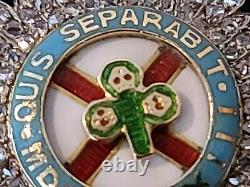
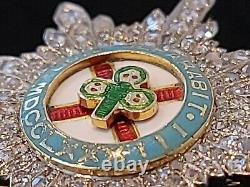
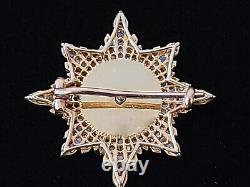
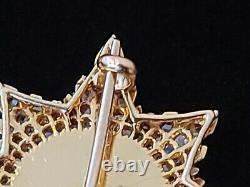
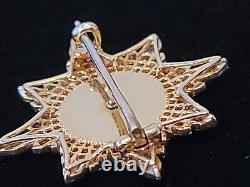
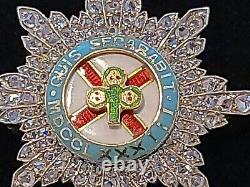
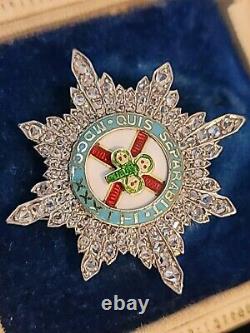


British Irish Crown Jewel King Edward Royalty Brooch UK. For your consideration is an exceedingly rare and historically important, one of a kind c. 1850s antique Royal Victorian 18K Gold / Diamond / enamel Irish Military Breast Star pin / brooch for The Most Illustrious Order St. Original 18k gold gemset royal breast star is miniature. Breast star measures approximately 30mm x 30mm.
Please note the size of this Star of St. Weight is 5.85 grams. Total carat weight of diamonds is estimated to be between 1.0 - 1.5 ct.
Gemset star with 114 natural rose / old mine cut diamonds. Diamonds are set in platinum or white gold. Verso of brooch is constructed entirely of 18K yellow gold. Condition is fine and original, with no repairs or restoration. Unmarked and unsigned, which is consistent with Jewels commissioned for the British Crown.Regarding provenance, very little exists on this royal brooch / pin. We can determine, based on the construction and style of the brooch, the star was likely made between 1850 and 1890. Given that assumption, and the fact that gemset diamond jewelry of this type and kind would have usually only been made for royalty, this Star of The Order of Saint Patrick could have possibly been made for. 17 November 1851 - Prince George of Cambridge / Prince George William Frederick Charles, Duke of Cambridge 26 March 1819 - 17 March 1904.
18 March 1868 - Eduard VII / Albert Edward, Prince of Wales (9 November 1841 - 6 May 1910) Later Edward VII, King of the United Kingdom. 30 March 1869 - Prince Arthur / Duke of Connaught. Prince Arthur William Patrick Albert (1 May 1850 - 16 January 1942) Later Duke of Connaught. The Most Illustrious Order of Saint Patrick is a dormant British order of chivalry associated with Ireland. The Order was created in 1783 by King George III at the request of the then Lord Lieutenant of Ireland, The 3rd Earl Temple (later created Marquess of Buckingham).The regular creation of knights of the Order lasted until 1922, when most of Ireland gained independence as the Irish Free State, a dominion within what was then known as the British Commonwealth of Nations. While the Order technically still exists, no knight of St Patrick has been created since 1936, and the last surviving knight, Prince Henry, Duke of Gloucester, died in 1974. Elizabeth II, however, remains the Sovereign of the Order, and one officer, the Ulster King of Arms (now represented in the office of Norroy and Ulster King of Arms), also survives. St Patrick is patron of the order; its motto is Quis separabit, Latin for Who will separate [us]? ":an allusion to the Vulgate translation of Romans 8:35, "Who shall separate us from the love of Christ?
Most British orders of chivalry cover the entire United Kingdom, but the three most exalted ones each pertain to one constituent country only. The Order of St Patrick, which pertains to Ireland, is the most junior of these three in precedence and age. Its equivalent in England, the Most Noble Order of the Garter, is the oldest order of chivalry in the British Isles, dating from the mid fourteenth century. The Scottish equivalent is the Most Ancient and Most Noble Order of the Thistle, dating in its present form from 1687.The order was founded in 1783, a year after the grant of substantial autonomy to Ireland, as a means of rewarding (or obtaining) political support in the Irish Parliament. The Order of the Bath, founded in 1725, was instituted for similar reasons. The statutes of the Order restricted membership to men who were both knights and gentlemen, the latter being defined as having three generations of "noblesse" (meaning ancestors bearing coats of arms) on both their father's and mother's side. In practice, however, only Irish peers and British princes were ever appointed to the Order.
The cross of St Patrick (a red saltire on a white background) was chosen as one of the symbols of the Order. A flag of this design was later incorporated into the Union Flag.Its association with St Patrick or with Ireland prior to the foundation of the Order is unclear, however. One of the first knights was the 2nd Duke of Leinster, whose arms carry the same cross.
The last non-Royal member appointed to the Order was the 3rd Duke of Abercorn in 1922, who served as the first Governor of Northern Ireland. When the Irish Free State left the United Kingdom in December of that same year, the Irish Executive Council under W.Cosgrave chose to make no further appointments to the Order. Since then, only three people have been appointed to the Order, all members of the British Royal Family. The then-Prince of Wales (the future King Edward VIII and later Duke of Windsor) was appointed in 1927 and his younger brothers, Prince Henry, Duke of Gloucester, in 1934 and Prince Albert, Duke of York (later King George VI), in 1936.
The Constitution of Ireland of 1937 provides that "Titles of nobility shall not be conferred by the State" (Article 40.2.1°) and "No title of nobility or of honour may be accepted by any citizen except with the prior approval of the Government" (Article 40.2.2°). Legal experts are divided on whether this clause prohibits the awarding of membership of the Order of St Patrick to Irish citizens, but some suggest that the phrase "titles of nobility" implies hereditary peerages and other noble titles, not lifetime honours such as knighthoods.This argument does not address the words "or of honour" however. The last living non-royal recipient, the 9th Earl of Shaftesbury, died in 1961. Prince Henry, Duke of Gloucester, at his death in 1974, was the last surviving knight. However, the Order is technically extant with a Sovereign and one officer, Norroy and Ulster King of Arms.
Prime Minister Winston Churchill suggested reviving the Order in 1943 to recognise the services in North Africa of General the Hon. Sir Harold Alexander, a member of an Ulster Scots family from County Tyrone, but the opinion of the other ministers and civil servants was that it would upset the diplomatic balance between London and Dublin. Taoiseach Seán Lemass considered reviving the Order during the 1960s, but did not take a decision.
The British monarch is the Sovereign of the Order of St Patrick. The Lord Lieutenant of Ireland, the monarch's representative in Ireland, served as the Grand Master. The office of Lord Lieutenant was abolished in 1922; the last Lord Lieutenant and Grand Master was The 1st Viscount FitzAlan of Derwent. Initially, the statutes of the Order did not provide that the Grand Master be admitted to the Order as a matter of right. While some Lords Lieutenant were in fact appointed to the Order, this seems to have been the exception rather than the rule. In 1839, Queen Victoria altered this and, though not a member during his Grand Mastership, he was permitted to retain the insignia after his term of office. The Order originally consisted of fifteen knights in addition to the Sovereign.In 1821, however, George IV appointed six additional knights; he did not issue a Royal Warrant authorising the change until 1830. William IV formally changed the statutes in 1833, increasing the limit to twenty-two knights.
The original statutes, based heavily on those of the Order of the Garter, prescribed that any vacancy should be filled by the Sovereign upon the nomination of the members. Each Knight was to propose nine candidates, of whom three had to have the rank of Earl or higher, three the rank of Baron or higher, and three the rank of Knight or higher, and a vote taken. In practice this system was never used; the Grand Master would nominate a Peer, the Sovereign would usually assent, and a chapter meeting held at which the knights "elected" the new member.The Order of St Patrick differed from its English and Scottish counterparts, the Orders of the Garter and the Thistle, in only ever appointing peers and princes. Women were never admitted to the Order of St Patrick; they were not eligible to become members of the other two orders until 1987.
The only woman to be part of the Order was Queen Victoria, in her capacity as Sovereign of the Order. Although it was associated with the established Church of Ireland until 1871, several Catholics were appointed to the order throughout its history.
The Order of St Patrick initially had thirteen officers: the Prelate, the Chancellor, the Registrar, the Usher, the Secretary, the Genealogist, the King of Arms, two heralds and four pursuivants. Many of these offices were held by clergymen of the Church of Ireland, then the established church. After the disestablishment of the Church in 1871, the ecclesiastics were allowed to remain in office until their deaths, when the offices were either abolished or reassigned to lay officials.
All offices except that of Registrar and King of Arms are now vacant. The office of Prelate was held by the Lord Archbishop of Armagh, the most senior clergyman in the Church of Ireland. The Prelate was not mentioned in the original statutes, but created by a warrant shortly afterwards, apparently because the then Archbishop asked to be appointed to the post. Since the death of the last holder in 1885, the office has remained vacant. The Church of Ireland's second highest cleric, the Lord Archbishop of Dublin, originally served as the Chancellor of the Order.
From 1886 onwards, the office was held by the Chief Secretary for Ireland. Since the abolition of the position of Chief Secretary in 1922, the office of Chancellor has remained vacant. [25] The Dean of St Patrick's Cathedral was originally the Registrar of the Order. In 1890, on the death of the Dean who had held the post in at the time of disestablishment, the office was attached to that of the King of Arms of the Order. This position was held by Ulster King of Arms, Ireland's chief heraldic official, a post which had been created in 1552. In 1943, this post was in effect divided in two, reflecting the partition of Ireland in the Government of Ireland Act 1920. The position, insofar as it related to Northern Ireland, was combined with that of Norroy King of Arms (who had heraldic jurisdiction in the north of England). The post of Norroy and Ulster King of Arms still exists, and thus continues to hold the offices of Registrar and King of Arms of the Order of St Patrick.The office of Ulster King of Arms, insofar as it related to the Irish Free State (now officially called Ireland), became the position of Chief Herald of Ireland. The Order had six other heraldic officers, many more than any other British order.
The two heralds were known as Cork and Dublin Heralds. Three of the four pursuivancies were untitled, the fourth was held by Athlone Pursuivant, founded in 1552. The Usher of the Order was "the Usher at Arms named the Black Rod". The offices of Secretary and Genealogist were originally held by members of the Irish House of Commons. The office of Secretary has been vacant since 1926.The position of Genealogist was left vacant in 1885, restored in 1889, but left vacant again in 1930. For important occasions, such as Coronations and investitures of new members of the Order, Knights of St Patrick wore elaborate vestments. The mantle was a celestial blue robe lined with white silk. The star of the Order (see below) was depicted on the left of the mantle. A blue hood was attached to the mantle.
The hat of the Order was originally of white satin, lined with blue, but was changed to black velvet by George IV. It was plumed with three falls of feathers, one red, one white and one blue. The collar was made of gold, consisting of Tudor roses and harps attached with knots. The two roses which comprise the Tudor rose were alternately enamelled white within red, and red within white.The central harp, from which the badge of the Order was suspended, was surmounted by a crown. Aside from these special occasions, much simpler accoutrements were used.
The star of the Order was an eight-pointed figure, with the four cardinal points longer than the intermediate points. Each point was shown as a cluster of rays. In the centre was the same motto, year and design that appeared on the badge. The star was worn pinned to the left breast. The broad riband was a celestial blue sash worn across the body, from the right shoulder to the left hip.
The sash of the Order of the Garter, darker in colour, is worn from the left shoulder. The badge was pinned to the riband at the left hip. Made of gold, it depicted a shamrock bearing three crowns, on top of a cross of St Patrick and surrounded by a blue circle bearing the motto in majuscules, as well as the date of the Order's foundation in Roman numerals ("MDCCLXXXIII").
The Grand Master's insignia were of the same form and design as those of the Knights. In 1831, however, William IV presented the Grand Master with a star and badge, each composed of rubies, emeralds and Brazilian diamonds. These two insignia were designated "Crown Jewels" in the Order's 1905 Statutes, and the designation "Irish Crown Jewels" was emphasised by newspapers when they were stolen in 1907, along with the collars of five Knights; they have not since been recovered. A number of items pertaining to the Order of St Patrick are held in museums in both the Republic of Ireland and Northern Ireland. The robes of The 4th Baron Clonbrock, the 122nd Knight of the Order, are on display in the National Museum of Ireland, Dublin; the robe belonging to The 3rd Earl of Kilmorey is held by the Newry Museum; the National Gallery and Genealogical Museum in Dublin both have Stars of the Order; and the Ulster Museum (part of the National Museums and Galleries of Northern Ireland) in Stranmillis has a large collection on display and two mantles in storage.The Irish Guards take their capstar and motto from the Order. This item is in the category "Collectibles\Historical Memorabilia\Royalty Collectibles". The seller is "galleryoff5th" and is located in this country: US. This item can be shipped worldwide.
- Features: Antique
- Modified Item: No
- Vintage: Yes
- Country: Ireland
- Royal: Victoria (1837-1901)
- To Commemorate: The Most Illustrious Order of Saint Patrick
- Theme: Royalty
- Royalty: British Royalty
- Country/Region of Manufacture: United Kingdom
- Year: 1850
- Type: Medal
- Brand: Unbranded


